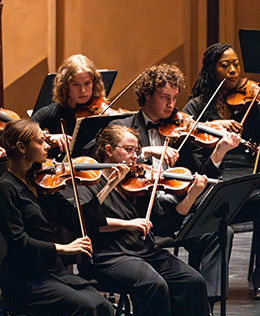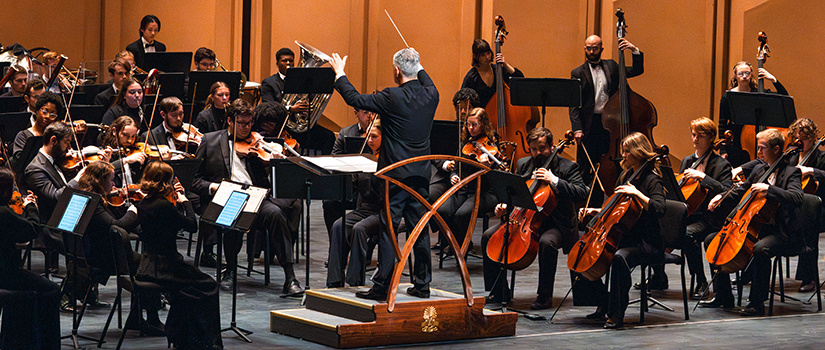The USC Symphony Orchestra will wrap up its season with two “massive events” this month, says conductor Scott Weiss.
On Saturday, the orchestra will accompany the Joffrey Ballet, one of the nation's premier dance companies, when it debuts a new work at the Koger Center for the Arts. The unprecedented performance, which culminates the troupe’s three-week residency at the University of South Carolina, will showcase both dance and music students.
“The repertoire musically is really interesting,” Weiss says. “It ranges from Vivaldi and Verdi to a piece that was written just a few years ago. It's going to be a beautiful night of dance and music.”
Katie Rojas, a junior violinist from Columbia, South Carolina, who is seeking a music education degree, calls the collaboration an amazing opportunity for student musicians. She is especially excited to perform Verdi’s “Birthday Variations,” a classical dance showpiece featuring fast footwork and high-flying leaps.
 Music performance major Olivia Norton, a senior flutist from Maryville, Illinois,
says the performance is a “unique chance to work with another art form and gain valuable
experience in performing alongside dancers, which will further improve my musicianship.”
Music performance major Olivia Norton, a senior flutist from Maryville, Illinois,
says the performance is a “unique chance to work with another art form and gain valuable
experience in performing alongside dancers, which will further improve my musicianship.”
On April 22, the School of Music will present a performance of Beethoven’s Ninth Symphony at the Koger Center as part of its centennial celebration. Featuring the USC Symphony Orchestra, the USC Concert Choir, the University Chorus, and solos by the voice faculty, Weiss calls it the exclamation point on the special events held throughout the year to commemorate the 100th anniversary. A second performance will be staged at St. John’s Methodist Church in Newberry, South Carolina, on April 25.
Known for its iconic “Ode to Joy” chorus, the groundbreaking work was Beethoven’s final complete symphony and the first by any composer to incorporate vocal soloists and chorus.
“For many years, we've been ending our season with a concert combined with the choirs, and as we thought about a piece for this centennial year, one thing became clear,” Weiss says. “It had to be Beethoven's Ninth. The piece moves from darkness to light, and in the end, unbridled joy. It seemed like the fitting finale for our centennial season.”
Rojas, who plans to teach middle or high school orchestra after graduation, says the masterpiece showcases the power of orchestral and choral unity.
“The final movement, with its ‘Ode to Joy’ theme, carries a message of hope making it a wonderful experience for the audience and performers,” she adds.
Our primary focus is making sure our students are prepared to be versatile performers and teachers in a variety of styles. So yes, they need to play Beethoven and Brahms and Schumann and Tchaikovsky. But they also need to play music from the Baroque period and music from the 20th and 21st centuries.
— Scott Weiss, Sarah Bolick Smith Distinguished Professor of Music / Director of Orchestras
A premier collegiate ensemble
Conducted by Weiss, director of orchestras since 2017, the USC Symphony Orchestra is the premier orchestra in the School of Music and one of the leading ensembles in the Southeast. The auditioned ensemble features a diverse mix of more than 80 student musicians. Most are music majors, but students in other majors who have a passion for music can also audition and perform.
The robust six-concert season each year and collaborations with touring soloists such as pianist Awadagin Pratt and violinist Melissa White position it among the premier collegiate orchestras. Weiss says these opportunities provide students with diverse performance experiences, enhancing their skills and versatility as musicians.
Cellist Carol Murray (’90 bachelor’s, music education) says playing in the orchestra not only helped prepare her for her 30-year career as a public school teacher but also provided memorable performances such as playing for Pope John Paul II's visit to South Carolina in 1987, the opening of the Koger Center and a performance at the Smithsonian Institution. Cellist and composer Buffi Jacobs (’97 bachelor’s, music performance), remembers performing alongside renowned artists such as Tony Bennett, Marvin Hamlisch, Burt Bacharach and Mark O'Connor.
The orchestra’s repertoire spans five centuries of music, including everything from the standard symphonic literature to cutting edge contemporary works.
“A focus of mine is depth and breadth – going deeply into as many different kinds of music as possible,” says Weiss, who is also conductor of the Aiken (South Carolina) Symphony. “Our primary focus is making sure our students are prepared to be versatile performers and teachers in a variety of styles. So yes, they need to play Beethoven and Brahms and Schumann and Tchaikovsky. But they also need to play music from the Baroque period and music from the 20th and 21st centuries.”
Jacobs, who has been a member of the national tour of Hamilton and a regular substitute in Broadway musicals, says the assigned repertoire was of professional caliber.
“Although we were students, we were expected to meet these high standards,” she says. “This environment pushed me to excel and grow as a musician.”
The orchestral student experience
A student-centered, world-class faculty that provides a personalized and caring environment combined with varied and abundant performance opportunities make the USC School of Music an appealing program for young musicians.
“The guidance, expertise and mentorship have helped me build a strong foundation as a musician,” Norton says. “There are also numerous opportunities to enhance my skill set beyond regular coursework, such as SPARK’s ProSkills series, which regularly features guest speakers sharing valuable industry expertise.”
Weiss says the individual attention and care that faculty show for students is one of his favorite things about teaching at USC.
“We look out for our students, and they get as customized of an education as they’ll find anywhere,” he says. “I like that about this place so much. No one's going to be just a cog in the wheel.”
Jacobs says the faculty provided guidance and inspiration by encouraging her to seek new opportunities and challenge herself. She says her career was shaped by three influential professors: Robert Jesselson, Donald Portnoy and Bert Ligon.
She explains Portnoy provided a wealth of ensemble performance opportunities and emphasized the importance of active listening; while Ligon expanded her musical horizons with jazz, alternative style and improvisation.
“Dr. Robert Jesselson taught me to be my own teacher in the practice room, ensuring that I used my time efficiently,” Jacobs says. “He never allowed me to avoid my challenges. Instead, he encouraged me to tackle technical barriers head-on with a methodical approach, set realistic goals, and hold myself accountable.”
Jesselson, a distinguished professor emeritus who teaches cello and was the conductor of the USC Symphony from 1981-1986, emphasizes that performance opportunities, such as playing in ensembles and participating in masterclasses, provide valuable training and experience for students.
“The university orchestras perform an amazing repertoire to develop students' skills and prepare them for professional careers,” he says. “Over the years, they've had fantastic opportunities with Donald Portnoy, Dick Goodwin and now Scott Weiss.”
Norton, who plans to seek a master’s degree after graduation, says she attended orchestra concerts when she was a freshman and was impressed by the high level of musicianship.
“Seeing the precision and artistry of the university’s orchestra made me want to be part of it and contribute to that standard of excellence,” she says. “In addition, working with a wind quintet has deepened my understanding of chamber music and its complexities. These opportunities have broadened my understanding of modern repertoire and equipped me with the skills to be a versatile and dynamic musician.”
Rojas says participating in orchestra with other passionate and talented musicians enhances her skills and allows her to learn something new at every rehearsal.
Other performance opportunities include the strings-only Campus Orchestra, which offers students who cannot commit to the USC Symphony an opportunity to continue playing. The Campus Orchestra, which comprises primarily non-music majors, meets once a week and performs one concert per semester. The USC Symphony also provides a smaller ensemble of about 20 players for USC Opera at Drayton Hall. Weiss maintains a rotation to ensure the best players participate in this opportunity.
Growing a program
When Jesselson joined the School of Music faculty in the early 1980s as a cello professor and conductor, his primary goal was the growth and development of the small string program and to fully staff the orchestra.
He started by inviting community string players and pre-college students to join the orchestra, seeking better performance venues and raising awareness for the ensemble. An early publicity effort was a performance of the Haydn Toy Symphony, which featured various toy instruments played by some notable community figures, including South Carolina Gov. Dick Riley's wife.
Jesselson also was director of the nascent String Project, a community outreach program in which university students teach young children string instruments. Jesselson built the String Project into one of the country’s largest and most prominent string education programs. Gail Barnes took over as director in 1997 and has continued the program’s impact on the Midlands and beyond.
“Through the String Project, we gradually attracted more string majors to the university, and one by one, all the school districts in the area started string programs as a direct result of the university’s outreach,” Jesselson says.
Jesselson credits that outreach and the availability of more scholarship funding for the significant expansion of the string program with additional faculty and students. Under his leadership, the orchestra also grew to about 100 musicians.
In addition to her music education courses, Rojas says teaching private lessons and classes through the String Project is giving her valuable experience for her career as a teacher. Murray, who is retired from the classroom but continues to play with the South Carolina Philharmonic, says it prepared her for her many years in public schools.
“I was able to observe a master teacher twice a week, as well as being observed by a master teacher. I felt very comfortable from day one in my classroom,” she says.
Jesselson says he is impressed by the diverse careers of his students who are teaching, performing and working in other music fields.
“I have fantastic students who are all around the country. Some are freelance performers, some have college teaching careers, some are playing on Broadway or in Hollywood,” he says. “I played with the South Carolina Philharmonic in a recent performance. It was really fun because there were nine cellists, and seven of them were my former students.”
Sing Thy High Praise: 100 Years of Music at Carolina
To commemorate its centennial year, the School of Music is showcasing its programs, alumni, students and faculty in a special series of stories and performances throughout the year. To read more about the yearlong celebration, click here. The theme for the historic milestone, “Sing Thy High Praise: 100 Years of Music at Carolina,” is pulled from the first line of USC’s alma mater.
- 6:30 p.m. Saturday: A special Joffrey Ballet performance featuring student dancers and accompaniment by the USC Symphony Orchestra. The Joffrey Ballet is one of the premier dance companies in the world today, with a reputation for boundary-breaking performances. Ticket information.
- 7:30 p.m. April 22: USC Symphony Orchestra and Choirs of Carolina present Beethoven’s Ninth. Soloists include Tina Milhorn Stallard, soprano; Rachel Calloway, mezzo-soprano; Dominic Armstrong, tenor; and Jacob Will, bass-baritone. Ticket information.
